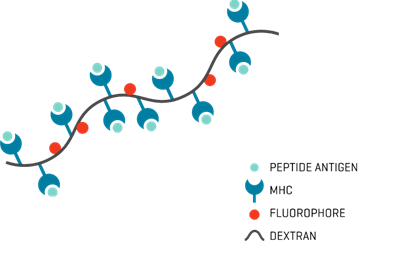Get the case study as a PDF.
Assessment of a Novel Vaccine’s Safety and Efficacy in High-Grade Glioma Patients, Using MHC I Dextramer® and Mass-Cytometry-Based Platform
Background
Diffuse midline gliomas (DMGs), including diffuse intrinsic pontin glioma (DIPG), are fast-growing, high malignancy brain tumors that often occur in children and result in poor outcomes. H3.3K27M, a uniformly expressed neoantigen shared among patients with DMGs or DIPG, represents a valuable immunotherapy target.
This study is the first pilot trial assessing a novel H3.3K27M-targeted peptide vaccine's safety and efficacy in pediatric patients with high-grade glioma.

Study Description
Based on HLA-A*02.01+ and H3.3K27M+ status and adequate organ function, 29 newly diagnosed patients (aged 3-21 years) were enrolled in this study:
- Stratum A: 9 patients with DIPG
- Stratum B: 10 patients with nonpontine DMGs, including spinal cord DMGs
The vaccine was administered in combination with the helper tetanus toxoid (TT) peptide and poly-ICLC every 3 weeks for 8 cycles, followed by once every 6 weeks. Nine patients with DIPG received concurrent oral dexamethasone treatment.
HLA-A*02:01-H3.3K27 Dextramer® staining was used to monitor H3.3K27M epitope-specific CD8+ T cells in patient-derived PBMCs using flow and mass cytometry.
Results
- Administration of the H3.3K27M-specific vaccine was well tolerated with no grade-4 treatment-related adverse events (TRAEs)
- Mass cytometry-based detection of H3.3K27M-reactive CD8+ T cells was as sensitive as conventional flow cytometry using H3.3K27 Dextramer® staining (Fig.1)
- The expansion of H3.3K27M-reactive CD8+ T cells was associated with prolonged overall survival (OS): median OS 16.3 months for immunological responders compared with 9.9 months for non-responders
- Dexamethasone treatment was associated with lower vaccine efficacy in patients with DIPG


Fig.1. Mass cytometry-based detection of H3.3K27M- reactive CD8+ T cells is as sensitive as conventional flow cytometry using H3.3K27M Dextramer®. CD8+ T cells were detected from the same patient on both flow cytometry (above) and mass cytometry (below), exhibiting comparable percentages of overall CD8+ T cells that were identified as H3.3K27M-reactive.
Conclusions
- The H3.3K27M-specific vaccine revealed a safe regimen and potent efficacy in overall survival in patients with DIMGs and DIPG
- Mass cytometry-based analysis combined with MHC I Dextramer® staining of H3.3K27-specific CD8+ T-cells provides a powerful platform for precise cellular immune monitoring of vaccine responses
- MHC I Dextramer® reagents “exhibit higher affinity and specificity for epitope-specific CD8+ T cell populations in comparison with conventional HLA tetramers”
- MHC I Dextramer® equally ensures higher resolution on both flow and mass cytometry workflows

